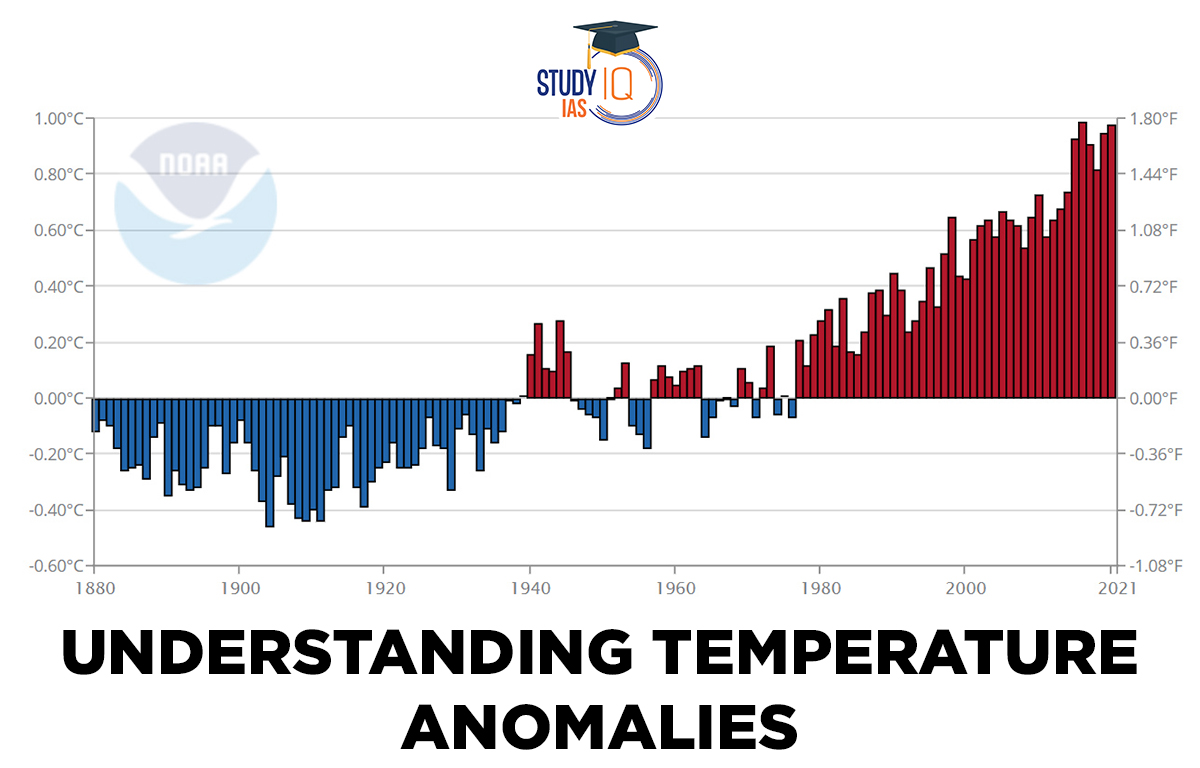Table of Contents
Context: Recent reports have highlighted that March 2023 was the second warmest March on record.
Temperature Anomaly
- Temperature anomaly represents a departure from a reference value or long-term average, which is normally chosen as an average of temperatures over a certain reference period.
- What are the causes of Temperature anomaly?
- Greenhouse gas emissions: The emissions of greenhouse gases such as Carbon dioxide, Methane etc have increased rapidly, affecting the Earth’s heat budget. This has a major impact on global temperatures.
- Decline in albedo: Albedo is the reflective capability of a surface. The albedo of the earth, which was higher due to presence of polar ice caps, has declined significantly. As reflective capacity declines, more heat is absorbed.
- Solar activity: Solar activity also plays a role in Earth’s temperature profile. Even though it has no major role in global warming, it can influence Earth’s climate.
- Natural factors: Natural events such as volcanic eruptions release large quantities of aerosols in the atmosphere, which has an effect on cooling of the planet.
Temperature Anomalies in March
- While March 2023 was the second warmest March on record, March 2016 was the warmest of March. This event was triggered by a ‘mini’ global warming because of the biggest El Niño of the 21st century.
- During an ‘El Niño year’, warmer water spreads in a band from west to east over the equatorial Pacific Ocean. In a ‘La Niña year’, cooler water spreads east to west in the same region.
- Both these phenomena create distinct and significant effects on the global climate.
- March in India marks the beginning of summer season. Some March may be cooler due to other climate factors, such as a La Niña.
- Causes:
- Increase in heat zones: Since maximum heating zone runs along central India regions between Odisha and Gujarat, temperatures start soaring in March.
- Decline in pre-monsoon showers: The lack of pre-monsoon showers has contributed to the overall heating. Rainfall due to western disturbances has not been below normal.
Impact of warmer March on India
- Temperature variations: Weather anomaly, due to warming to the west to north of India led to cooler March over Mumbai, excess pre-monsoon rains over the northwest and scorching heatwaves in Kerala and Odisha.
- Weaker western disturbances: Due to warmer temperatures, the effects of western disturbances was subdued. This deprives northern parts of India from much needed winter rainfall.
- Prolonged heatwaves: Rapid warming of Middle-East and northern Arabian Sea has enhanced the duration, frequency, and intensity of heat waves over India in the pre-monsoon season.
- Stronger monsoon and cyclogenesis: A warmer Arabian Sea as a result of weather anomaly can favour a stronger monsoon but may also enhance cyclonic circulation over the Arabian Sea.
- Stronger monsoons have the potential to produce heavy rainfall events over northwest India and Pakistan.
- Weaker El Niño: Warmer March has reduced snowfall over the Eurasian landmass, which tends to favour a stronger monsoon.
- Even though 2023 is expected to be an El Niño year (which tends to produce weaker monsoons), its effect could be blunted by the lower snow cover over Eurasia.
- Crop damage: Rabi crops require cooler temperatures for optimal output. Weather anomaly in form of warmer temperatures may lead to crop damage, affecting food security.
Way Forward
- Global warming does not mean each month or each year will be warmer than the previous month/year. Instead it is a long term phenomenon that is more visible over decades.
- Climate scientists will have to provide context while comparing temperature data so that people at large understand global warming better as well as its cascading effects on the weather.
- Effects of global warming locally can be a better way of conveying people about its effects rather than on a global scale. This will motivate them on climate action.
El Niño vs La Niña
El Niño–Southern Oscillation(ENSO)
- ENSO is an irregular periodic variation in winds and sea surface temperatures over the tropical eastern Pacific Ocean, affecting the climate of much of the tropics and subtropics.
- The warming phase of the sea temperature is known as El Niño and the cooling phase as La Niña.
| Comparison | El Niño | La Niña |
| Meaning | El Niño means Little Boy, or Christ Child in Spanish. | La Niña means Little Girl in Spanish. |
| Sea surface temperature | It represents the periodic warming of sea-surface temperatures across the east-central equatorial Pacific. | It represents the periodic cooling of sea-surface temperatures across the east-central equatorial Pacific. |
| Pressure | It is laden with high air surface pressure in the western Pacific. | It contain low air surface pressure in the eastern Pacific |
| Formation | During El Niño, trade winds weaken. Warm water is pushed back east, toward the west coast of the Americas, resulting in a weaker Walker cell. | During La Niña , trade winds are even stronger than usual, pushing more warm water toward Asia, resulting in a stronger Walker cell. |
| Period of occurence | Typically occure every 3-5 years and lasts 9-12 months. | Typically occur every 3-5 years and lasts 1-3 years. |
| Impacts | Droughts in eastern Australia
Flooding in western South America Weak upwelling over the west coast of South America. |
Excessive rainfall in the eastern Australia
Drought conditions prevail in the South America Strong upwelling over the west coast of South America. |
| Impact on Indian Monsoon | The monsoon is affected so heavily that 70% reduction of the rainfall is expected. The winds doesn’t carry the moisture towards Indian landmass dueing El Nino causing deficiency in rainfall. | La Nina causes high temperatures over the Indian Ocean, off the Somalian coast and a comparatively better monsoon rains in India. |


 Micrometeoroids: Tiny Space Particles, M...
Micrometeoroids: Tiny Space Particles, M...
 India Needs a National Insolvency Tribun...
India Needs a National Insolvency Tribun...
 Unlocking the Potential of India–Afric...
Unlocking the Potential of India–Afric...

























